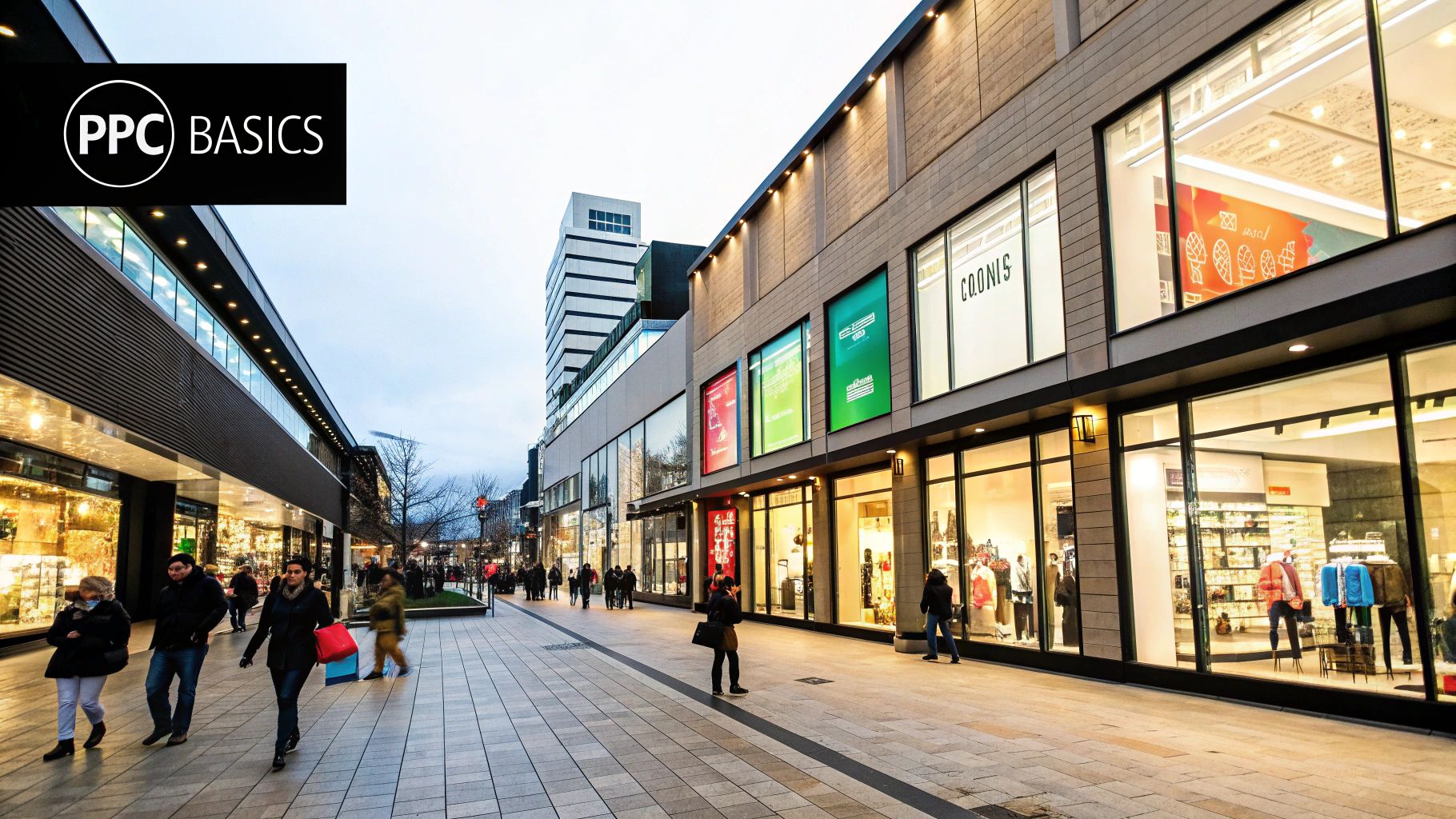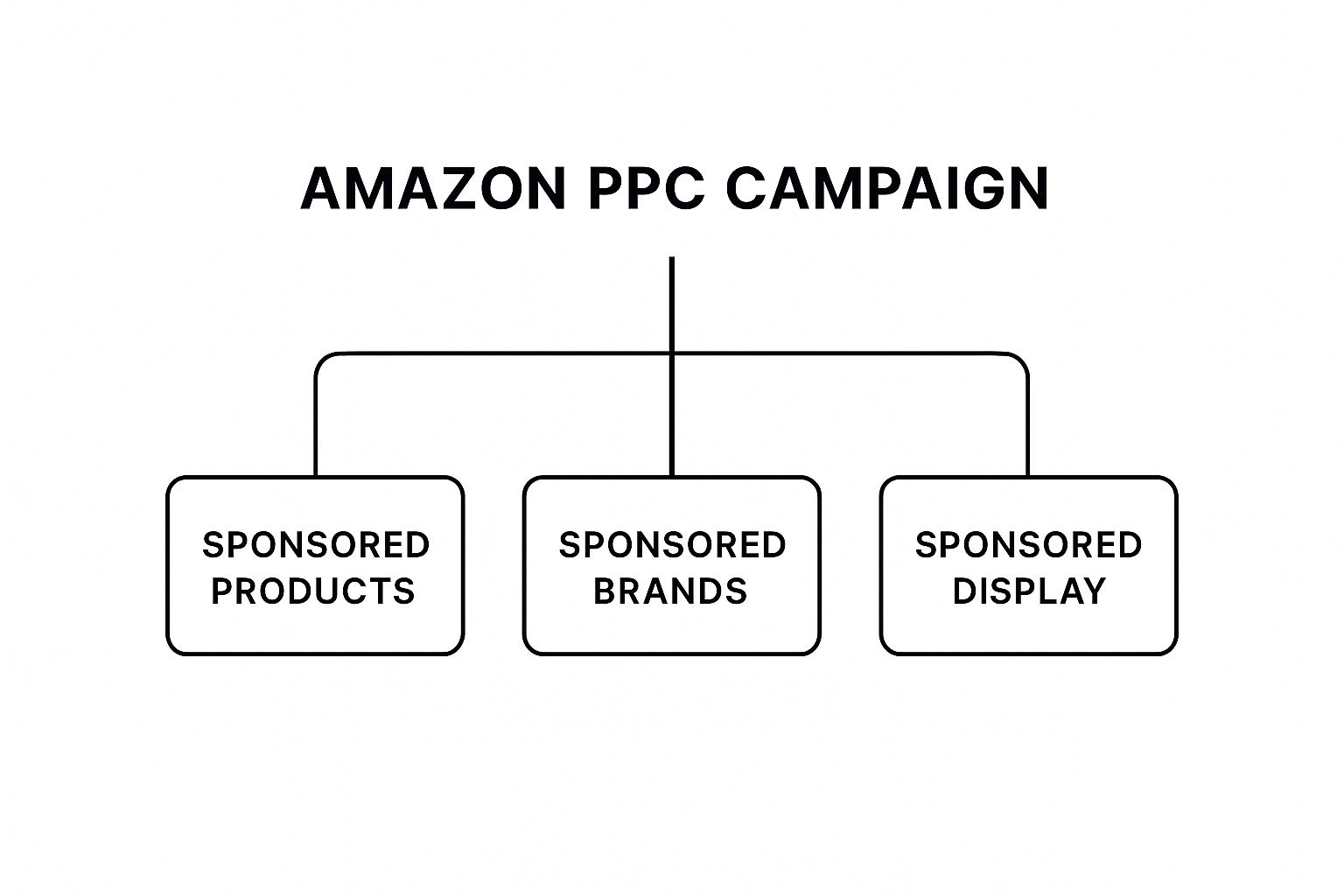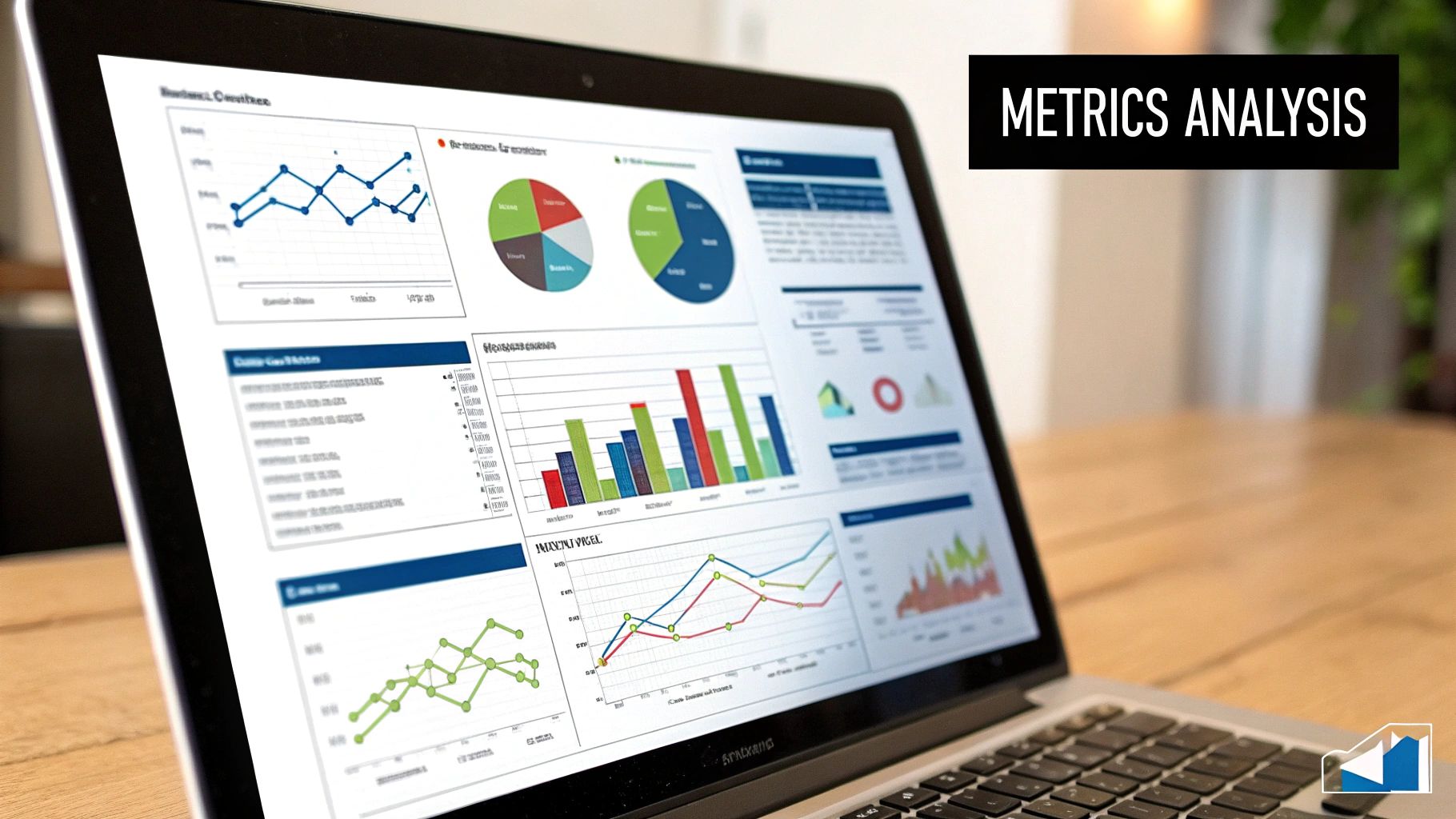Master PPC on Amazon: Boost Sales & Visibility

Amazon PPC is simply a form of advertising where you, the seller, pay a fee each time a shopper clicks on your ad. It’s a Pay-Per-Click model, and it’s your ticket to getting your products into the best spots on Amazon’s digital shelf, giving them immediate visibility to customers ready to buy.
How PPC on Amazon Actually Works
Picture Amazon as a gigantic, bustling high street. Millions of products are all shouting for attention, so getting your item noticed is a tough gig. Amazon PPC is your way of renting the prime shop window, putting your product right in front of shoppers who are actively looking for something just like it.
It all runs on a real-time auction system. Sellers bid on specific keywords to win the best ad placements.
When a customer types “eco-friendly water bottle” into the search bar, Amazon instantly holds an auction among all the advertisers bidding on that exact phrase. The winners get their ads shown in prime real estate, like right at the top of the search results page. But it’s not just about who bids the most; Amazon also looks at your product’s relevance and past performance to figure out which ad will give the customer the best experience.
The Core Purpose of Amazon Advertising (Master PPC on Amazon)
So, why bother paying for clicks? It’s much more than just a short-term traffic boost; it’s a strategic tool for serious growth. PPC gives you a direct line to visibility that building up organic rankings could take months, or even years, to achieve. This is absolutely essential for new products that need to get those first crucial sales and build momentum.
Here’s what running PPC campaigns really does for you:
- Immediate Visibility: Your product can land on the first page of search results within minutes of launching a campaign. No more waiting around and hoping to climb the organic ladder.
- Sales Velocity: Every sale you make from an ad contributes to your product’s overall sales history. This is a massive signal to Amazon’s algorithm, helping to push your organic search ranking up. More sales mean a better organic spot.
- Data and Insights: Your campaigns are a goldmine of data. You’ll learn exactly which keywords are converting, giving you a deep understanding of how customers search and helping you fine-tune everything from your ad strategy to your product listings.
This screenshot from Amazon’s own advertising portal shows you can reach customers at every single stage of their buying journey.

It makes it clear that advertising isn’t just about closing the sale. It’s about building awareness and being considered long before the customer even adds an item to their basket.
The ultimate goal here is to create a ‘flywheel effect.’ Your paid ads boost sales, which in turn improves your organic ranking. This powerful cycle means your initial ad spend becomes a long-term investment in free visibility.
At the end of the day, getting good at PPC isn’t just about paying for traffic. It’s about strategically placing your products to capture demand and fuel real, sustainable growth. Once you get your head around the auction and its purpose, you can turn your ad spend into a powerful engine for your UK-based business. For more advanced strategies, you can find a wealth of useful Amazon PPC tips to further refine your approach.
Master PPC on Amazon: Choosing Your Amazon PPC Campaign Type
Once you’ve got your head around why you should be using PPC on Amazon, the next step is picking your weapons. Not all ads are created equal, and Amazon gives you a specialised toolkit with three core campaign types. Each is designed for a different job, popping up in different places and working towards specific goals for your business.
Think of it like a marketing toolbox. You wouldn’t use a sledgehammer to hang a picture, and you wouldn’t use a tiny screwdriver to knock down a wall. Picking the right campaign type is all about matching the tool to the task. Your three main options are Sponsored Products, Sponsored Brands, and Sponsored Display.
This simple diagram shows how these three core types branch out from the main Amazon PPC framework.

This hierarchy makes it clear that each campaign serves a distinct function within your bigger advertising strategy. Let’s break down exactly what each one does and how you can get the most out of them.
Sponsored Products: The Workhorse of Sales
Sponsored Products are the ads you see everywhere on Amazon; they’re the bread and butter of most sellers’ strategies. Think of these as your frontline sales drivers, pushing individual product listings right into the shopping results and onto product detail pages.
Their main job is to grab the attention of shoppers who are already searching for products just like yours and are ready to buy.
- Where They Appear: You’ll spot Sponsored Product ads at the top, middle, and bottom of search results pages, and in a carousel on competitor or complementary product pages.
- What They Achieve: Their primary goal is simple: drive direct sales. They’re perfect for giving new products a visibility boost, clearing out old stock, or putting your best-sellers in the spotlight.
- Best Use Case: Imagine you sell a popular brand of reusable coffee cups. A Sponsored Product ad makes sure your cup appears when a customer searches for “insulated travel mug,” putting you right in front of an eager buyer.
Sponsored Brands: Your Digital Billboard (Master PPC on Amazon)
While Sponsored Products laser-focus on a single item, Sponsored Brands are all about building your brand’s reputation and showing off a collection of products. Consider them your brand’s headline act, taking up that prime real estate at the very top of the search results.
These ads feature your brand logo, a custom headline, and up to three of your products. When a shopper clicks on the logo or headline, they can be whisked away to your brand’s Amazon Storefront for a much more immersive shopping experience.
Sponsored Brands are less about the immediate sale and more about introducing your entire brand to a new audience. They help build recognition and trust, which really pays off down the line.
Recent updates have made these campaigns even more potent. Amazon PPC advertising in the UK now includes enhanced targeting, letting sellers target customers by demographics, interests, and past purchases. This means you can craft ads that speak directly to the shoppers most likely to love what you do. You can find more insights in these Amazon PPC strategies for UK sellers.
Sponsored Display: The Retargeting Engine
Sponsored Display is your secret weapon for bringing shoppers back and stretching your reach way beyond Amazon’s search results. These ads are a different beast entirely because they aren’t triggered by keywords. Instead, they target shoppers based on what they’ve been doing.
This campaign type lets you “follow” customers who have previously checked out your product, a similar one, or fall into a specific interest group.
- Re-engage Past Visitors: You can show ads to shoppers who looked at your product detail page but didn’t buy. It’s a gentle nudge, reminding them about your product as they browse other pages on Amazon or even on third-party websites and apps.
- Target a Competitor’s Audience: You can place your ads right on your direct competitors’ product pages, offering an alternative just as a customer is about to make a choice.
- Reach New Audiences: Target shoppers based on their proven interests (e.g., people who often buy eco-friendly products) or if they’ve viewed products in related categories.
A UK-based skincare brand, for example, could use Sponsored Display to show ads for their new moisturiser to customers who recently bought facial cleansers, even if it was from another brand. It’s a proactive way to find new customers who have already shown they’re in the market for skincare. By strategically blending all three campaign types, you can build a full-funnel machine that not only drives sales today but also builds brand loyalty for tomorrow.
Master PPC on Amazon: Finding Customers with Keywords and Targeting
Keywords are the very heart of Amazon PPC. They’re the bridge connecting what a shopper is searching for with the product you’re trying to sell. Getting this right is absolutely fundamental to any successful PPC on Amazon strategy. Your first big decision is how you’re going to unearth these valuable search terms, which leads us to the two main targeting types.

Ultimately, this choice comes down to one thing: how much control you want right out of the gate. You can either let Amazon’s algorithm do the heavy lifting for you, or you can take the reins yourself from day one.
Automatic Targeting: Your Research Assistant
Think of an automatic campaign as sending out a scout. You don’t hand Amazon a list of specific keywords. Instead, you just give it your product listing and a budget, then let it work its magic. Amazon will then start matching your ad to a whole host of customer searches and related product pages that its algorithm thinks are a good fit.
The main objective here isn’t instant profit—it’s data collection. Automatic campaigns are a fantastic way to discover how real people are actually searching for products just like yours. You’ll often dig up some surprisingly effective keywords you’d never have dreamed of on your own.
After letting an automatic campaign run for a week or two, you need to dive into the search term report. This report is an absolute goldmine. It shows you the exact queries customers used that led to clicks and sales, which you can then “harvest” for your manual campaigns.
Manual Targeting: Taking Direct Control (Master PPC on Amazon)
Once you’ve got a solid list of keywords that you know work, it’s time to get specific with manual targeting. This is where you tell Amazon exactly which keywords you want to bid on, how much you’re willing to pay for each click, and what match type to use. It gives you precise, granular control over where your ad budget goes.
This is the point where you can really start optimising your campaigns for profitability, funnelling your budget into the search terms that you know convert well. To make this work, you need to get your head around the different keyword match types.
Demystifying Keyword Match Types
Imagine you’re going fishing. You wouldn’t use the same net to catch every kind of fish, would you? Keyword match types are the same idea. They let you decide how precise your targeting needs to be. You’ve got three main options:
- Broad Match: This is like casting a massive net. Your ad might show up for searches that include your keyword in any order, plus synonyms, plurals, and other close variations. If your keyword is “leather wallet,” your ad could appear for “men’s wallet leather” or even “genuine card holder.” It gives you the widest possible reach but can sometimes pull in irrelevant traffic.
- Phrase Match: This is a more controlled, tighter net. Your ad will show for searches containing your exact keyword phrase in the right order, but it can have other words before or after it. For “leather wallet,” your ad might appear for “black leather wallet for men” but not for “wallet made of leather.”
- Exact Match: This is like using a spear. Your ad will only show up when a shopper types in your precise keyword, with very few variations. For “leather wallet,” it pretty much has to be that exact search. This ensures maximum relevance but comes with a much smaller volume of traffic.
The Power of Negative Keywords (Master PPC on Amazon)
Telling Amazon which keywords to target is only half the battle. Telling it which ones to avoid is just as important. Negative keywords are terms you add to your campaign to stop your ad from appearing on irrelevant searches. This is easily one of the most effective ways to slash wasted ad spend.
For example, if you sell premium “leather wallets” but not cheap “faux leather wallets,” you’d add “faux” and “cheap” as negative keywords. This simple move prevents you from paying for clicks from shoppers who are looking for something you don’t even offer.
While keyword targeting helps your ads get seen, understanding what is audience targeting can add another powerful layer to your strategy, letting you reach specific customer segments beyond just what they type into the search bar. Getting your targeting right is the foundation of an efficient and profitable PPC campaign.
Master PPC on Amazon: Managing Your Bids and Advertising Budget
Nailing your PPC on Amazon isn’t just about picking the winning keywords; it’s a game of smart financial management. You need to tell Amazon exactly how much you’re willing to pay for a single click, and what you’re prepared to spend each day. Getting this balance right is the secret to running profitable campaigns that don’t burn a hole in your pocket.
Think of your budget as the fuel for your campaign. A daily budget is the maximum amount you’re willing to spend on a campaign in a single day. While Amazon might occasionally spend a little more on high-traffic days to seize opportunities, it promises never to exceed your total monthly budget (your daily budget multiplied by the number of days in the month).
Setting a realistic budget from the get-go is critical. It’s often best to start with a figure you’re comfortable with, maybe £20-£30 per day, just to gather some initial data without risking too much cash. Once you see which campaigns are actually delivering, you can confidently start funnelling more funds their way.
Choosing the Right Bidding Strategy
Your bidding strategy is your instruction manual for Amazon, telling it how to spend your money in the ad auction. This is a crucial setting that directly shapes your campaign’s performance and how cost-effective it is. Amazon gives you three main options, each with a completely different approach.
- Dynamic Bids – Down Only: This is the safest bet. Amazon will automatically lower your bid in real-time if a click looks less likely to convert into a sale. It’s a conservative approach designed to stop you from wasting money.
- Dynamic Bids – Up and Down: This is a much more aggressive strategy. Amazon has the power to increase your bid (by a maximum of 100% for top-of-search placements) if a click seems highly likely to convert, and will lower it otherwise. This can help you capture more valuable impressions, but you need a higher tolerance for risk.
- Fixed Bids: With this option, what you bid is what you get. Amazon will use your exact bid for every single auction, without making any adjustments based on conversion likelihood. This gives you ultimate control but can be massively inefficient if you’re not watching it like a hawk.
For most new campaigns, starting with ‘Dynamic bids – down only’ is the smartest move. It protects your budget while you collect performance data, allowing you to make much more informed decisions down the line.
To get even more granular with your financial control, it’s essential to explore various PPC bidding strategies that can be applied to different campaign goals and stages of growth.
Measuring Your Profitability: ACoS and RoAS (Master PPC on Amazon)
So, how do you actually know if your ad spend is making you money? Two core metrics give you the answer: Advertising Cost of Sale (ACoS) and Return on Advertising Spend (RoAS). Getting to grips with these will help you make decisions based on hard data, not guesswork.
ACoS tells you what percentage of your sales revenue was eaten up by advertising costs. The formula is beautifully simple: (Total Ad Spend ÷ Total Ad Sales) x 100. A lower ACoS is better, as it means you’re spending less to generate each sale. If you spent £100 on ads and made £500 in sales, your ACoS would be 20%.
RoAS is just the other side of the coin. It shows you how much revenue you earn for every single pound you spend on ads. The formula is Total Ad Sales ÷ Total Ad Spend. Using that same example, your RoAS would be £5 (£500 in sales ÷ £100 in ad spend). With RoAS, a higher number is always better.
Understanding these two metrics is what allows you to set clear, achievable profitability targets for every campaign you run.
Optimising Your Costs
The cost-per-click (CPC) for Amazon ads in the UK isn’t static; it ebbs and flows throughout the year. On average, the CPC sits around £0.75, but this can dip to £0.62 in slower months and shoot up to £0.86 during peak seasons like July.
For UK sellers, this means you have to be actively working to lower your CPC. Smart tactics like audience segmentation, optimising your ad placements, and diligently using negative keywords are essential for improving your return, especially when you’re trying to reach a slice of Amazon’s colossal audience of over 240 million Prime members. You can explore more about these global trends and discover insights about Amazon advertising statistics on sequencecommerce.com.
Master PPC on Amazon: Making Sense of Your Campaign Performance Metrics

Your campaign data is telling you a story. The real skill in running effective PPC on Amazon is learning how to read that story and make smart, data-driven decisions. While a metric like ACoS gives you a quick snapshot of profitability, you need to dig deeper into other key performance indicators (KPIs) to truly diagnose problems and spot opportunities.
Think of your campaign dashboard like a car’s diagnostic system. An engine warning light (your high ACoS) tells you something’s wrong, but it doesn’t tell you what. To figure that out, you need to check the oil pressure, engine temperature, and other specific readings. For your campaigns, that’s exactly what metrics like Impressions, CTR, and Conversion Rate do.
Decoding the Core Metrics
To get the full picture, you need to understand what each KPI is actually measuring and, more importantly, how they all connect. It’s in that relationship where the most valuable insights are hiding.
Let’s break down the essentials you should be watching:
- Impressions: This is simply how many times your ad was shown to a shopper. It’s a measure of pure visibility. High impressions mean you’re winning auctions and getting seen.
- Clicks: This is the number of times someone actually clicked on your ad after seeing it. Clicks are the first real signal of genuine interest.
- Click-Through Rate (CTR): Calculated as (Clicks ÷ Impressions) x 100, this metric shows the percentage of people who saw your ad and were interested enough to click. A healthy CTR usually means your main image and ad copy are hitting the mark.
- Conversion Rate (CVR): This is the percentage of clicks that turned into a sale. It measures how well your product detail page convinces shoppers to buy after they’ve clicked your ad.
Connecting the Dots to Diagnose Problems (Master PPC on Amazon)
The real magic happens when you start looking at these metrics together. One metric on its own can be misleading, but when you combine them, they tell a clear story about your campaign’s health.
For example, here’s a classic scenario: you have a campaign with tons of impressions and a strong CTR, but the ACoS is through the roof because of a low conversion rate. The high CTR proves your ad is grabbing attention and is relevant to the search. So, the ad itself isn’t the problem; it’s what happens after the click that’s failing.
This pattern almost always points to an issue on your product detail page. Maybe your price is too high, your product images are weak, you don’t have enough positive reviews, or your bullet points just aren’t selling the benefits effectively.
The average Amazon PPC conversion rate hovers around 9-10%, which is already miles ahead of the typical e-commerce rate of 1.33%. For UK sellers with well-optimised product listings, getting your CVR above that average is completely achievable. You can check out more findings about Amazon advertising stats on adbadger.com.
By mastering these fundamental key performance indicators for digital marketing, you can stop guessing what’s wrong and start knowing exactly where to focus your efforts. This data-first approach is the secret to cutting wasted spend, boosting profitability, and successfully scaling your ads.
Common Questions About PPC on Amazon
Diving into the world of Amazon PPC throws up a lot of questions, especially for UK sellers who want to get it right from the start. We’re going to tackle the real-world questions we hear all the time from brands, whether they’re just starting out or looking to fine-tune their ad spend.
We’ll cover the big ones: from how much to spend when you’re new, to when you can expect to turn a profit, and how your ads can actually boost your organic sales.
How Much Should I Spend on Amazon PPC When Starting Out?
This is the million-dollar question, isn’t it? The honest answer is there’s no magic number that fits everyone. The best way to think about your initial budget isn’t about making instant profit, but about buying data. You’re investing in learning what actually works for your products.
For most new sellers in the UK, a daily budget of £20 to £50 per campaign is a solid place to begin. It’s enough to gather useful data in the first couple of weeks without putting your business at massive risk. This gives you the runway to see which keywords are pulling in traffic and, more importantly, which ones are converting into sales.
Here’s why that range works:
- Going too low is a false economy. A tiny £5 daily budget might seem safe, but your ads will likely run out of steam before lunchtime. This starves your campaign of data, drags out the learning phase, and makes it impossible to draw any real conclusions.
- A healthy starting budget works smarter. Spending £20+ a day lets your ads run from morning till night, capturing clicks during peak shopping times and quieter periods alike. This gives you a much richer, more reliable set of data to work with when it’s time to optimise.
Once you’ve identified a few winning keywords from these early tests, you can start reallocating your budget with confidence, pushing more spend towards what you know is working.
How Long Until My PPC Campaigns Are Profitable? (Master PPC on Amazon)
Patience is everything in Amazon advertising. It’s so important to understand that new campaigns almost never make money from day one. Think of the first two to four weeks as the “data-gathering phase.” Your goal here isn’t profit; it’s learning.
It’s like training a new employee. You wouldn’t expect them to be your top performer on their first day. You invest time showing them the ropes, and only then do you start seeing a real return. Your PPC campaigns are no different—they need time to collect performance data before you can start moulding them into lean, low-ACoS (Advertising Cost of Sale) machines.
You have to go in expecting a new campaign to be a loss-leader at first. This mindset stops you from making knee-jerk decisions. Turning off a campaign after a week because it’s not profitable is one of the most common mistakes we see. You’ve just paid for all that valuable data, only to throw it away.
After that initial learning period, the real work begins. You’ll start optimising by:
- Harvesting Keywords: Pulling the best-performing search terms from your automatic campaigns and placing them into manual campaigns for tighter control.
- Adding Negative Keywords: Telling Amazon which irrelevant search terms to stop showing your ads for, preventing wasted spend on useless clicks.
- Refining Bids: Tweaking your bids based on real conversion data. You’ll bid up on the keywords making you money and pull back on the ones that aren’t.
With consistent, data-driven tweaks, most sellers should see their campaigns heading towards their target ACoS within 4 to 8 weeks. In super-competitive niches, it might take a bit longer, but the process is always the same.
Can Amazon PPC Improve My Organic Ranking?
Yes, absolutely. This is one of the most powerful—and often overlooked—benefits of running great PPC campaigns on Amazon. The link between your paid ads and your organic search position is what we call the “flywheel effect,” and it’s fundamental to any long-term success on the platform.
Amazon’s A9 algorithm loves one thing above all else: products that sell. One of the clearest signals you can send it is sales velocity—quite simply, how many units your product sells over a certain time.
Here’s how you get that flywheel spinning:
- You launch a PPC campaign, driving instant, highly targeted traffic to your product page.
- This extra traffic leads to more sales.
- The spike in sales velocity signals to Amazon that your product is a great match for those specific keywords.
- In response, Amazon starts bumping up your product’s organic ranking for those very same keywords.
This creates a brilliant, self-sustaining cycle. As your organic rank improves, you get more “free” clicks and sales, which reinforces your sales history and cements your high ranking. Over time, you can even start to dial back your ad spend on keywords where you’ve secured a top organic spot, making your entire operation more profitable.
Feeling a bit lost in the weeds with your campaigns? The expert team at PPC Geeks can help. We build data-driven strategies that boost sales and cut out wasted spend, leaving you free to focus on growing your business. Find out how we can help by visiting us at https://ppcgeeks.co.uk.
Author
Search Blog
Free PPC Audit
Subscribe to our Newsletter
The Voices of Our Success: Your Words, Our Pride
Don't just take our word for it. With over 100+ five-star reviews, we let our work-and our satisfied clients-speak for us.
"We have been working with PPC Geeks for around 6 months and have found Mark and the team to be very impressive. Having worked with a few companies in this and similar sectors, I rate PPC Geeks as the strongest I have come across. They have taken time to understand our business, our market and competitors and supported us to devise a strategy to generate business. I value the expertise Mark and his team provide and trust them to make the best recommendations for the long-term."
~ Just Go, Alasdair Anderson
